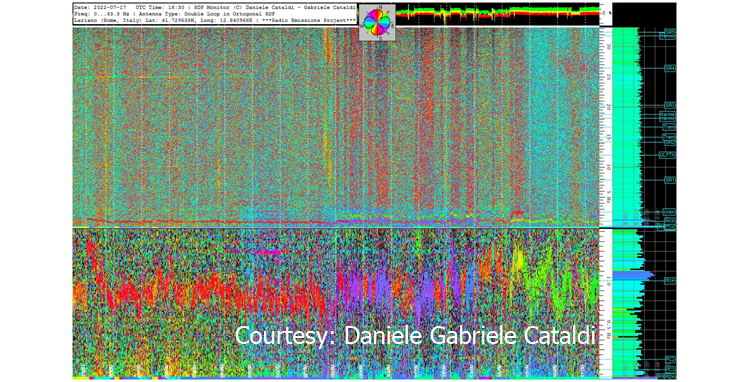Atmospheric plasmas research linked to electromagnetic signals and earthquakes
DOI:
https://doi.org/10.15587/2706-5448.2022.270465Keywords:
piezoelectricity, extremely low frequency, earthquakes, radio direction finding network, energy plasmasAbstract
This paper presents the outcome of monitoring aimed at studying seismic precursor candidates with a multi-parameter system, carried out at a Science Camp in July 2022 in the northwestern Italian Apennines, in the province of Parma. Pre seismic signals, closely related to the preparatory stages of an earthquake, were detected with a crustal diagnosis, based on physical signals, generated by tectonic stress. The instrumental results show a potential temporal concatenation, which describe, at the level of hypothesis, the phases of the ongoing tectonic stress. The model followed Zou’s theories who which associate the formation of plasmas in the atmosphere with the piezoelectricity of rocks under stress. According to his model, rocks placed under tectonic stress and in the presence of moisture can produce both charged particles and radio electromagnetic waves, at high and low frequencies. A spherical plasmoid would originate from this combination as a wave-particle interaction effect. According to Teodorani’s description High-Frequency radio waves-particularly microwaves-would heat and ionize the surrounding air, while low-frequency waves, particularly Very Low Frequencies and Extremely Low Frequency, would help condense the plasma, which in turn would immediately go into swirling motions within it, until it formed the «self-contained» structure seen in the sky as a light phenomenon. Monitoring, therefore, involved the detection of low-frequency waves preceding plasmas in the atmosphere, directional electromagnetic signals from the Radio Direction Finding (RDF) network, and the occurrence of an earthquake within the 5/6 days’ time window along the same fracture line. A study model that, if confirmed, could be applied to other seismic zones for crustal monitoring.
Supporting Agency
- Presentation of research in the form of publication through financial support in the form of a grant from SUES (Support to Ukrainian Editorial Staff).
References
- Tsukuda, T. (1997). Sizes and Some Features of Luminous Sources Associated with the 1995 Hyogo-ken Nanbu Earthquake. Journal of Physics of the Earth, 45 (2), 73–82. doi: https://doi.org/10.4294/jpe1952.45.73
- Straser, V. (2020). Atmospheric Plasmas that Precede Earthquakes in Seismically Active Areas. Plasma Tectonics and Electric Geology, 62–67.
- Ikeya, M., Yamanaka, C., Mattsuda, T., Sasaoka, H., Ochiai, H., Huang, Q. et al. (2000). Electromagnetic pulses generated by compression of granitic rocks and animal behavior. Episodes, 23 (4), 262–265. doi: https://doi.org/10.18814/epiiugs/2000/v23i4/004
- Adams, M. H. (1990). Some Observations of Electromagnetic Signals Prior to California Earthquakes. Journal of Scientific Exploration, 4 (2), 137–152.
- Nagao, T., Enomoto, Y., Fujinawa, Y., Hata, M., Hayakawa, M., Huang, Q. et al. (2002). Electromagnetic anomalies associated with 1995 Kobe earthquake. Journal of Geodynamics, 33 (4-5), 401–411. doi: https://doi.org/10.1016/s0264-3707(02)00004-2
- Molli, G., Carlini, M., Vescovi, P., Artoni, A., Balsamo, F., Camurri, F. et al. (2018). Neogene 3-D Structural Architecture of The North-West Apennines: The Role of the Low-Angle Normal Faults and Basement Thrusts. Tectonics, 37 (7), 2165–2196. doi: https://doi.org/10.1029/2018tc005057
- Straser, V. (2007). Precursory luminous phenomena used for earthquake prediction The Taro Valley, North-western Apennines, Italy. New Concepts in Global Tectonics Newsletter, 44, 17–31.
- Freund, F. T. (2003). Rocks that Crackle and Sparkle and Glow–Strange Pre-Earthquake Phenomena. Journal of Scientific Exploration, 17 (3), 37–71.
- Straser, V., Cataldi, G., Cataldi, D. (2020). Radio direction finding for short-term crustal diagnosis and pre-seismic signals. The case of the Colonna Earthquake, Rome (Italy). European Journal of Advances in Engineering and Technology, 7 (7), 46–59.
- Teodorani, M. (2004). A long-Term Scientific Survey of the Hessdalen Phenomenon. Journal of Scientific Exploration, 18, 217–251.
- Zou, Y.-S. (1995). Some physical considerations for unusual atmospheric lights observed in Norway. Physica Scripta, 52 (6), 726–730. doi: https://doi.org/10.1088/0031-8949/52/6/022
- Istituto Nazionale di Geofisica e Vulcanologia. Available at: https://www.ingv.it/
- Bunnell, J. (2009). Hunting Marfa Lights. Lacey Publishing Co. Dallas-Fort Worth Area.
- St-Laurent, F., Derr, J. S., Freund, F. T. (2006). Earthquake lights and the stress-activation of positive hole charge carriers in rocks. Physics and Chemistry of the Earth, Parts A/B/C, 31 (4-9), 305–312. doi: https://doi.org/10.1016/j.pce.2006.02.003
- Bychkov, A. V., Ardelyan, N. V., Kosmachevshii, K. V. (2017). Complex Geophysical conditions of air ionization and Hessdalen lights. Proceedings of 2nd International Symposium on Lightning and Storm-Related Phenomena, ISL-SRP 2017. Aurillac, 8.
- Nikitin, A. I., Bychkov, V. L., Nikitina, T. F., Velichko, A. M. (2015). New cases of measuring of ball lightning energy. 1st International Symposium on Lightning and Storm Related Phenomena, ISL-SRP-2015. Aurillac, 25.

Downloads
Published
How to Cite
Issue
Section
License
Copyright (c) 2022 Valentino Straser

This work is licensed under a Creative Commons Attribution 4.0 International License.
The consolidation and conditions for the transfer of copyright (identification of authorship) is carried out in the License Agreement. In particular, the authors reserve the right to the authorship of their manuscript and transfer the first publication of this work to the journal under the terms of the Creative Commons CC BY license. At the same time, they have the right to conclude on their own additional agreements concerning the non-exclusive distribution of the work in the form in which it was published by this journal, but provided that the link to the first publication of the article in this journal is preserved.







